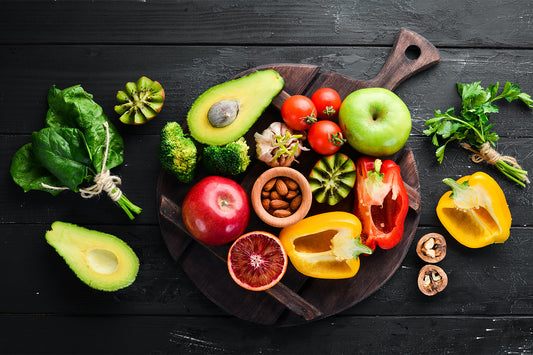Oceans make up 71 percent of the Earth’s surface, and those oceans are filled with beautiful and sometimes mysterious marine life and fish species. Unfortunately, we don’t treat this marine life with much care, and commercial fishing practices do cause harm to ocean ecosystems and food webs.
There is a bright side, though. Changing the way we view nutrition can help provide a solution. Embracing algae as one option for supporting our health and nutrition may help us take steps in the right direction.
What Is the Overfishing Problem?
On a basic level, overfishing is the concept of catching too many fish at one time, which prevents fish from being able to reproduce and replenish their populations. Some world organizations consider overfishing to be one of the most significant threats to our oceans today, contributing to endangered species.
The number one reason for overfishing is commercial fishing, as fishers deplete fisheries — aka areas where fish can be found– for the sake of profit. The extensive fishing gives little time for these ecosystems to repair themselves. Not only does fishing reduce fish populations, but so does the damage that happens as a byproduct of the process.
One of the most significant issues in the fishing industry today is bycatch — the process of fishermen unintentionally catching sea creatures they do not want or cannot sell and discarding them back into the ocean.
Bycatch affects fish, but it also greatly impacts animals that shouldn’t be fished, like turtles, sharks, and dolphins. Bycatch is responsible for killing hundreds of thousands of sea creatures every year.
Altogether, overfishing takes fish out of the ocean and provides little space for fish populations to recover, which has a dangerous snowball effect on ocean ecosystems and beyond.
What Are the Risks and Effects of Overfishing?
Destructive fishing poses many unfortunate risks to sea creatures, the ocean, and the broader world when left unchecked. We can see many effects, and more risks are on the horizon if we don’t take action.
Declining Fish Populations
The number one risk of overfishing is the damaging effects on marine ecosystems. This damage starts by taking fish out of their natural habitats — the ocean is one giant food chain.
By taking fish out of the ocean, fishers take away vital food sources for larger ocean creatures like whales, sharks, and larger fish. Eliminating creatures from an environment throws off the entire balance, affecting other marine life and limiting biodiversity.
Damage to Marine Life
Overfishing has much wider effects than just on the fish that are caught. Trawling is the perfect example. Trawling is the process of fishing by dragging along a large net to catch fish. The issue with trawling is that it, of course, not only takes fish out of the ocean but also that towing the net results in dragging it across the seafloor.
In the process, trawling damages the seabed, disturbing the root systems of plants on the seafloor and animal burrows.
Like bycatching, this process has much broader effects on the ocean past just catching fish. Trawling can also affect the chemistry of the water by forcing sediment throughout the water. Altogether, the more fishing vessels pass through fisheries, the more harm they do to the ecosystems within them past just catching fish.
Ocean Pollution
Overfishing doesn’t just affect marine ecosystems by taking the fish out, but the remnants left behind are also harmful.
Fishing is a huge contributor to ocean pollution, as a significant portion of ocean pollution is the result of fish nets, fishing gear, and debris from fishing vessels. The more that overfishing occurs, the more fishers leave trash behind.
The Economy
Overfishing is also counterproductive for the economy. Currently, companies may benefit from fishing as much as they possibly can. However, over time, fish populations will become scarce, and it will be difficult for businesses to maintain this pace if there are no more fisheries to access. That reality may not be too far away if companies do not embrace change soon.
What Are Some Solutions to Overfishing?
Overfishing has been a discussion topic among governments and environmental groups for years, so many potential solutions are in place. These are some of the solutions that have been posed.
Quotas
Of course, the first reaction to the idea of fishing too much is to set limits. Governing bodies can set a total allowable catch limit, which designates how many fish can sustainably be caught during a designated timeframe.
Unfortunately, illegal fishing is a common problem, and it is hard for agencies to monitor and catch fishing vessels when they are out in the water. Some estimates in Europe claim that as many as 78 percent of total allowable catch recommendations have been ignored.
Fishing Rights
Similar to quotas is the concept of fishing rights. Unlike quotas, fishing rights focus more on territory by designating certain areas as fishing territories for specific groups or individuals. In many cases, fisheries and individuals fall into a race to catch all of the fish. However, fishing rights designate a catch share for each fishing group in the area.
One key issue with fisheries management is that for many fishermen around the world, fishing makes up their livelihoods.
Finding solutions that support all sides is challenging. Fishing rights are mutually beneficial for both fisheries and the environment, as they correlate to better fishery management and ensure everyone gets a fair share.
Subsidies
Another way that governments and agencies have addressed the fact that fishing is an important livelihood for many is by supporting financial subsidies to both fishers and agencies that can promote sustainable measures. These subsidies have supported agencies in increasing fish stocks to combat overfishing.
However, there are two sides to subsidies. These payments can be harmful, as subsidies to fishing companies can provide them with the resources to travel farther into fisheries and make overfishing worse.
Each of these solutions has its flaws, but there is one key solution that we can all embrace, even on an individual level — algae.
Can Algae Really Help With Overfishing?
Current measures are not making as much of an impact as they could because it is hard to regulate all of the actions of the fishing industry. For example, governments and agencies can set fishing limits and establish rules that affect fisheries. However, many of these regulations are difficult to enforce.
Sustainable seafood is an ambitious goal, to say the least — but algae may be a more sustainable option than fishing when possible.
Although many people turn to fish because they prefer to eat it, a significant portion of the population embraces fish for its nutritional value. Fatty, oily fish is one of the only sources of DHA and EPA omega-3 fatty acids, which offer benefits for supporting heart health, cognitive health, and overall health wellness. Fish oil supplements are another option for obtaining these omega-3 fatty acids, and they are taken daily by many.
Plus, krill oil has also become an increasingly popular supplement. Krill are small crustaceans that serve as food for a large amount of marine life. Altogether, the more that people rely on marine creatures for their daily nutrition, the more we contribute to overfishing and declining fish populations — this is why algae is such a valuable option for those who can turn to it.
Algae is rich in both DHA and EPA omega-3 fatty acids, and it can serve as a more than viable replacement for fish and fish oil supplements. The omega-3s in algae are absorbed 1.7x better than those in fish or krill oil, making them the more valuable option.
The truth is, algae alone can’t singlehandedly stop overfishing. Many populations rely on fish as a main source of protein, and algae may not be a perfect swap in all cases — however, it is still a powerful step in the right direction.
Is Algae Sustainable?

Since algae can help fill in some the nutritional gaps that moving away from fish could pose, algae may be a great way to help with overfishing. By serving as a source of antioxidants, omega-3 fatty acids, and even valuable protein, algae may be a long-term solution to supporting the nutrition of a large portion of the world’s population.
By turning to algae for our nutrition instead of fish, we can help reduce all the threats of fishing above. When produced the right way, algae can pose zero threat to the ocean at all. For example, at iwi life, we produce our algae using methods that limit the need for natural resources.
Our algae is produced in the deserts of Texas and New Mexico, far away from ocean creatures and without using valuable fresh soil. Salty water with some added nutrients and sunlight are the only natural resources used in this process. From start to finish, choosing algae is often better than relying on fish alone.
The benefits of algae for sustainability may run even deeper. The production of algae may provide a way to combat the effects of climate change. Algae can help to absorb carbon dioxide from the atmosphere and release oxygen instead. The combined benefits of algae make it an option we should all embrace when we can!
Turn to Algae for the Oceans
Overfishing is a complex issue, and the solutions are complex, too. However, embracing algae as an alternative to fishing is a strong start to a more sustainable future. With iwi life, replacing fish supplements in our diets becomes a lot easier.
Our algae-based omega-3 supplement offers a combined 250 mg of EPA and DHA omega-3 fatty acids, supporting our health and the environment all at the same time. Explore our complete family of iwi life omega-3 supplements and see all the potential benefits for yourself.
Sources:
Overfishing | Environmental Defense Fund
Understanding Bycatch | NOAA Fisheries
What a Drag: The Global Impact of Bottom Trawling | U.S. Geological Survey
















